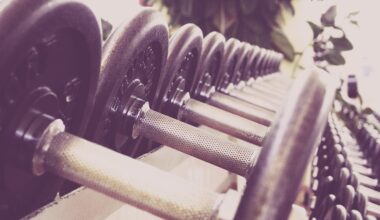Bar Path Drills to Optimize Your Snatch Efficiency
Improving your bar path during the snatch is essential for enhancing efficiency and power. To begin, let’s focus on the importance of visualizing the ideal bar path. Picture the bar moving in a straight line from the ground to its overhead position. Any deviations can add unnecessary strain on your body and detract from your performance. One effective drill to emphasize optimal bar path is the “Hip Snatch”. In this drill, try to keep the bar extremely close to your body as it ascends. This encourages better control and leverage for your lifts. Additionally, use a mirror or record your lifts to review your form. Observing your technique in real-time allows you to make necessary adjustments instantly. Working on stabilizing your shoulders during the lift is another vital component. Make sure to engage your lats effectively to prevent the bar from drifting away. Above all, focusing on gradual improvements will lead to remarkable gains over time. Consistency in performing these drills helps strengthen the neural pathways involved in the lift, ultimately leading to enhanced performance in future training or competitions.
Another beneficial drill for improving your bar path in the snatch is known as the “Snatch Pull”. This drill emphasizes the initial pull from the ground to the hips and reinforces the concept of maintaining a vertical bar path. When executing the snatch pull, focus on driving through your heels and extending your legs while keeping your torso upright. This ensures that the bar travels vertically as it’s elevated. While practicing this, always make sure your grip remains firm; a strong grip assists in maintaining control over the bar. For better results, consider implementing pauses at different positions during the lift, like the hip or knee. These pauses provide feedback on body mechanics and help in addressing technical issues. Incorporate pauses every few sets to really hone in on your snatch technique. Furthermore, using lighter weights when practicing allows you to concentrate solely on bar path awareness and form adjustment without sacrificing speed or power. Consistently repeating this drill will build muscle memory, making your snatch smoother and more efficient in the long run.
Incorporating Speed and Power
In addition to drills focused on bar path, integrating speed and power into your training regimen is crucial. One effective method is performing “Power Snatches”. By reducing the weight but maintaining intensity and speed, you can reinforce good bar position without the added fatigue of a full snatch. This exercise allows you to practice your technique while emphasizing explosive movement. As you lift, concentrate on accelerating the bar off the ground, moving quickly through your transition phases. The dynamic nature of this exercise helps stimulate fast-twitch muscle fibers responsible for generating power. Make sure to perform these power snatches with a focus on explosive hip extension and shoulder engagement, ensuring that you complete the lift in one fluid motion. As you become comfortable, progressively increase weight to challenge your adaptation over time. Pair power snatches with accessory lifts such as “Overhead Squats” to further promote stability in your pressing position. These lifts will help reinforce greater shoulder strength and positioning needed in a successful snatch drive, maximizing your potential each training session.
Another unique drill to optimize your snatch efficiency is practicing the “Hang Snatch”. This variation effectively trains the crucial second pull of the snatch, reinforcing control and high bar path. Begin with the bar resting around mid-thighs and initiate your lift from there. This will eliminate the influence of the initial pull from the ground, allowing you to focus purely on your upper body mechanics. The hang snatch ensures that you utilize your legs and hips explosively rather than relying solely on strength. When performing this drill, try focusing on jumping the bar upwards rather than simply pulling it, thereby targeting optimal trajectory. Incorporate a quick elbow turnover to receive the bar in the proper overhead position. Repeated practice with the hang snatch allows for better acceleration as well; perfecting the timing will improve overall snatching performance when you transition back to full lifts. Consider combining these with series of light cleans to build additional confidence in your catch phases. Always listen to your body and prioritize form to avoid injury while performing. Consistency with these drills will yield dividends in your overall weightlifting journey.
Importance of Mobility and Flexibility
A vital aspect of optimizing your snatch technique lies in focusing on mobility and flexibility. Effective snatch performance requires superb hip, shoulder and ankle flexibility to achieve the correct receiving position. If you notice limitations in these areas, incorporate mobility drills into your regimen. Dynamic stretching before and after training is essential for enhancing flexibility. Key movements such as the “Couch Stretch” or “A-Fraction Squat” target hip and ankle mobility. These stretches will progressively allow for deeper squatting positions and greater stability during lifts. Ensuring peak flexibility incorporates a proper warm-up routine including foam rolling. This can help loosen tight muscles before lifting. Additionally, utilizing resistance bands for shoulder mobility can significantly aid in establishing the correct overhead positions necessary for snatches. Aim to incorporate a dedicated 15-20 minutes of mobility work into your weekly schedule for optimal gains. Thus, regular mobility practice will reduce the risk of injury while significantly improving your overall lifting mechanics. By being proactive, you’ll discover increased range of motion, further enabling you to transition smoother into your full snatch lifts.
In conjunction with mobility work, nutrition plays an indispensable role in optimizing your performance as a weightlifter. Proper nutrition impacts your recovery, energy levels, and overall efficiency in lifting. Focus on eating a well-balanced diet rich in carbohydrates, proteins, and fats. Prepared meals high in complex carbohydrates, such as quinoa and oats, provide the necessary fuel for high-intensity training. Additionally, including protein-rich foods like chicken, fish, or legumes can support muscle recovery post-training. Remember to hydrate thoroughly as well because dehydration can negatively affect performance. Consider integrating a post-workout recovery supplement system into your routine to rebuild energy levels and support muscle growth. Observing your eating habits in conjunction with your workout goals will allow you to make necessary adjustments. Tracking your macros can further enhance your understanding of what helps your body recover best. If needed, consult a nutritionist to tailor a program best suited for your individual requirements. Combining nutritional knowledge with efficient training will ultimately maximize your strength, speed, and endurance during snatch lifts over time.
Progress Tracking and Mental Approach
Lastly, maintaining a method for tracking progress can greatly enhance your performance on the snatch. Keeping a training log or journal is an excellent way to document workouts and monitor gains. Detailing the weight used, number of reps, and any specific techniques practiced during each session will provide insights into your improvement over time. Recognizing patterns in your training can reveal areas that require additional focus and refinement. This self-awareness is crucial for athletes looking to enhance their techniques. Coupled with tracking your physical progress, it is imperative to adopt a resilient mental approach. Training the mind is as crucial as physical preparation. Utilize visualizations and affirmations to build mental strength and confidence in your abilities. Whenever you experience setbacks or plateaus, reflecting on your progress can foster mental resilience. Celebrate even small victories and use these to boost your motivation and recognize hard work. Engaging in a supportive weightlifting community, whether in-person or online, allows sharing progress and experiences, creating shared encouragement. By combining skill-focused practice with mental fortitude, optimizing snatch efficiency becomes a well-rounded process.
In summary, refining your snatch technique using various drills focusing on bar path, mobility, nutrition, and mindset greatly enhances overall efficiency. Be proactive in exploring diverse methods that resonate with your lifting style. The key is to prioritize practice while being mindful of maintaining proper form and technique regardless of the weights used. Integrating bar path drills, the hang snatch, speed-oriented exercises, and mobility work allows for incremental improvements. Nutrition fuels training and recovery processes, while tracking progress keeps motivation high in your weightlifting journey. Remember that lifting is not just a sport; it is a discipline that connects both the body and mind. Stay committed to your goals, trusting the process over tangible results. Over time, consistent practice and mindfulness in approach yields significant returns. Respect each training session and know that every little step taken influences your path towards success. Embrace the grind, enjoy the journey, and don’t hesitate to share insights learned with fellow lifters. Keep striving for personal excellence, and you’ll discover the secrets to unlocking your true potential in the snatch.


